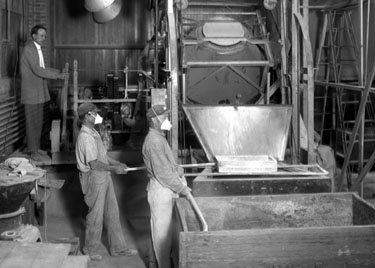The Optical Glass Rivalry
|
World War I greatly affected and touched the lives of nearly everyone in the United States. Goods like tin and gasoline had to be rationed. Thousands of men enlisted in the army, leaving their families without a male head of the household. Women were forced to fill their husbands' shoes, working in the factories or wherever else needed just to earn a dime. Hard times befell America. |
|||
|
|
|||
|
|||
|
|
|||
|
American glass companies did their best to fill Germany’s shoes. Nevertheless, efforts floundered due to the appearance of “lines”, or uneven composition, in the American-made glass. The companies just couldn’t seem to get the glass-making process right. On March 28, 1917, the Geophysical Laboratory’s director, A. L. Day informed Carnegie Institution of Washington President Woodward that he had several key ideas for how the Laboratory could contribute to the war effort. At the forefront of these ideas was the optical glass problem. Weeks after Day’s proposal, he was approached by George Ellery Hale, a Carnegie astronomer, who was working for the National Research Council. Hale officially petitioned for the Geophysical Laboratory’s help with optical glass, which Day directly accepted. |
|||
|
|
|||
|
|||
|
|
|||
|
The Geophysical Laboratory was not the only institution concentrating on the optical glass issue. Since 1915, the Bausch and Lomb Optical Company, the biggest manufacturer of American optical glass, and the National Bureau of Standards, a government agency, had been struggling with the very same concerns. Unlike the Geophysical Laboratory, their progress was slow and the results scarcely improved. In the spring of 1917, the National Research Council devised an ingenious plan to speed up and improve the optical glass making process. The Council recommended that the National Bureau of Standards join with the Pittsburgh Plate Glass Company and the Geophysical Laboratory with Bausch and Lomb to see who could produce the most good quality optical glass in a given period of time. The rivalry provided more than enough incentive for both teams. Carnegie invested the most research in the basic physical and chemical compositions of silicates. This focus proved strategic as by October of 1917, the winner of the optical glass race was already evident. Bausch and Lomb was regularly producing almost 40,000 pounds of government-accepted glass per month. By eight months, on the other hand, Pittsburgh Plate Glass had produced none. The failure was caused by a lack of cooperation with their partner, the National Bureau of Standards. No improvement was made, and Day was soon asked to take over their operations. |
|||
|
|
|||
|
|||
|
|
|||
|
In 1919, the Washington Evening Star reported that the National Bureau of Standards claimed sole credit for solving the optical glass problem, when the agency had, in fact, thrown in the towel after failing to achieve sufficient results. Furious, President Woodward wrote a letter to the Secretary of Commerce showing that of almost 700,000 pounds of glass made in the United States during the war, less than three percent came from companies other than Bausch and Lomb. Day and the Geophysical Laboratory were congratulated and honored for their incredible assistance to the United States during World War I. In a speech given by President Woodward in A. L. Day’s honor, the President predicted that “the historian of the Institution will understand more clearly what has been done than our contemporaries do.” The Geophysical Laboratory saved lives by simply improving the quality of war-time optical glass. This fact leaves one to wonder what would have resulted if Day hadn’t stepped in. |
|||
|
|
|||
|
References:
Further Reading:
|



